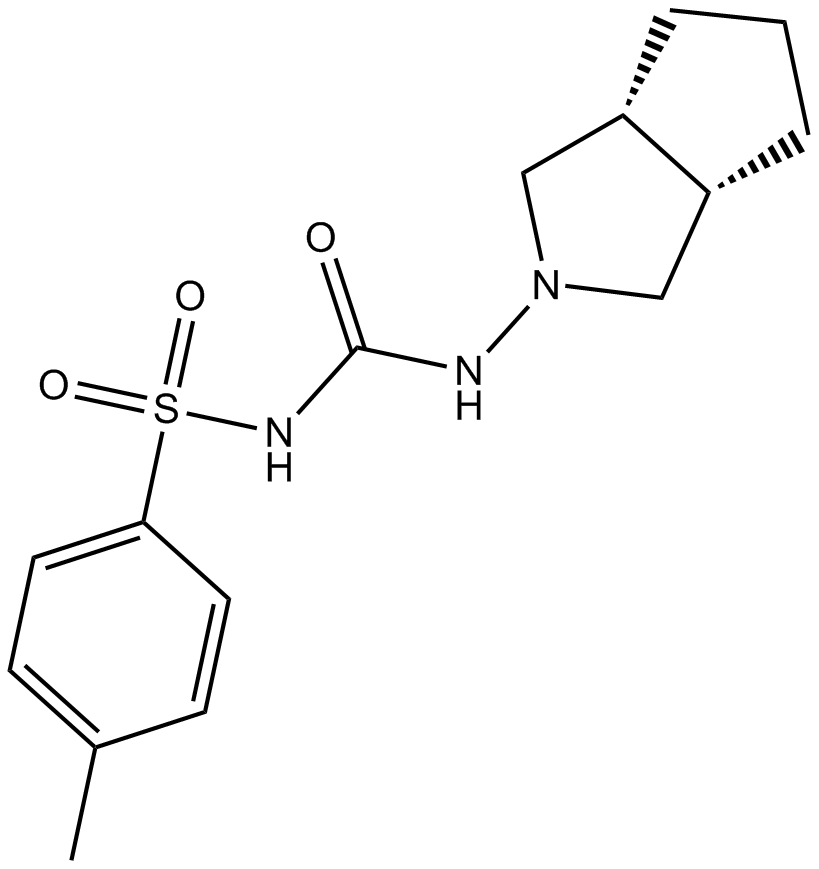Gliclazide |
| Catalog No.GC13527 |
Potassium channel inhibitor
Products are for research use only. Not for human use. We do not sell to patients.

Cas No.: 21187-98-4
Sample solution is provided at 25 µL, 10mM.
Gliclazide (S1702) is a whole-cell beta-cell ATP-sensitive potassium currents blocker with an IC50 of 184 nM. Gliclazide is used as an antidiabetic[1].
Gliclazide (S1702) further characterize its mechanism of hypoglycemic effect: the observed improvements in insulin sensitivity and in GLUT4 translocation indicate that gliclazide counters the hydrogen peroxide-induced insulin resistance in 3T3L1 adipocytes and also would further augment the hypoglycemic effect of this drug as insulinotropic sulfonylurea[1]. Gliclazide blocked whole-cell beta-cell KATP currents with an IC50 of 184 +/- 30 nmol/l (n=6-10) but was much less effective in cardiac and smooth muscle (IC50s of 19.5 +/- 5.4 micromol/l (n=6-12) and 37.9 +/- 1.0 micromol/l (n=5-10), respectively). In all three tissues, the action of the drug on whole-cell KATP currents was rapidly reversible. In inside-out patches on beta-cells, gliclazide (1 micromol/l) produced a maximum of 66 +/- 13 % inhibition (n=5), compared with more than 98 % block in the whole-cell configuration. Gliclazide is a high-potency sulphonylurea which shows specificity for the pancreatic beta-cell KATP channel over heart and smooth muscle. In this respect, it differs from glibenclamide[2].
References:
[1]. Shimoyama, T., et al., Gliclazide protects 3T3L1 adipocytes against insulin resistance induced by hydrogen peroxide with restoration of GLUT4 translocation. Metabolism, 2006. 55(6): p. 722-30.
[2]. Lawrence, C.L., et al., Gliclazide produces high-affinity block of KATP channels in mouse isolated pancreatic beta cells but not rat heart or arterial smooth muscle cells. Diabetologia, 2001. 44(8): p. 1019-25.
| Cas No. | 21187-98-4 | SDF | |
| Chemical Name | 1-(3,3a,4,5,6,6a-hexahydro-1H-cyclopenta[c]pyrrol-2-yl)-3-(4-methylphenyl)sulfonylurea | ||
| Canonical SMILES | CC1=CC=C(C=C1)S(=O)(=O)NC(=O)NN2CC3CCCC3C2 | ||
| Formula | C15H21N3O3S | M.Wt | 323.41 |
| Solubility | ≥ 15.6mg/mL in DMSO | Storage | Store at -20°C |
| General tips | Please select the appropriate solvent to prepare the stock solution according to the
solubility of the product in different solvents; once the solution is prepared, please store it in
separate packages to avoid product failure caused by repeated freezing and thawing.Storage method
and period of the stock solution: When stored at -80°C, please use it within 6 months; when stored
at -20°C, please use it within 1 month. To increase solubility, heat the tube to 37°C and then oscillate in an ultrasonic bath for some time. |
||
| Shipping Condition | Evaluation sample solution: shipped with blue ice. All other sizes available: with RT, or with Blue Ice upon request. | ||
| Prepare stock solution | |||

|
1 mg | 5 mg | 10 mg |
| 1 mM | 3.0921 mL | 15.4603 mL | 30.9205 mL |
| 5 mM | 0.6184 mL | 3.0921 mL | 6.1841 mL |
| 10 mM | 0.3092 mL | 1.546 mL | 3.0921 mL |
Step 1: Enter information below (Recommended: An additional animal making an allowance for loss during the experiment)
 g
g
 μL
μL

Step 2: Enter the in vivo formulation (This is only the calculator, not formulation. Please contact us first if there is no in vivo formulation at the solubility Section.)
Calculation results:
Working concentration: mg/ml;
Method for preparing DMSO master liquid: mg drug pre-dissolved in μL DMSO ( Master liquid concentration mg/mL, Please contact us first if the concentration exceeds the DMSO solubility of the batch of drug. )
Method for preparing in vivo formulation: Take μL DMSO master liquid, next addμL PEG300, mix and clarify, next addμL Tween 80, mix and clarify, next add μL ddH2O, mix and clarify.
Method for preparing in vivo formulation: Take μL DMSO master liquid, next add μL Corn oil, mix and clarify.
Note: 1. Please make sure the liquid is clear before adding the next solvent.
2. Be sure to add the solvent(s) in order. You must ensure that the solution obtained, in the previous addition, is a clear solution before proceeding to add the next solvent. Physical methods such as vortex, ultrasound or hot water bath can be used to aid dissolving.
3. All of the above co-solvents are available for purchase on the GlpBio website.
Quality Control & SDS
- View current batch:
- Purity: >99.50%
- COA (Certificate Of Analysis)
- SDS (Safety Data Sheet)
- Datasheet
Average Rating: 5 (Based on Reviews and 14 reference(s) in Google Scholar.)
GLPBIO products are for RESEARCH USE ONLY. Please make sure your review or question is research based.
Required fields are marked with *



















